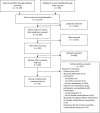Physical fitness interventions for nonambulatory stroke survivors: A mixed-methods systematic review and meta-analysis
- PMID: 29920979
- PMCID: PMC6043697
- DOI: 10.1002/brb3.1000
Physical fitness interventions for nonambulatory stroke survivors: A mixed-methods systematic review and meta-analysis
Abstract
Introduction: Physical fitness training after stroke is recommended in guidelines across the world, but evidence pertains mainly to ambulatory stroke survivors. Nonambulatory stroke survivors (FAC score ≤2) are at increased risk of recurrent stroke due to limited physical activity. This systematic review aimed to synthesize evidence regarding case fatality, effects, experiences, and feasibility of fitness training for nonambulatory stroke survivors.
Methods: Eight major databases were searched for any type of study design. Two independent reviewers selected studies, extracted data, and assessed study quality, using published tools. Random-effects meta-analysis was used. Following their separate analysis, qualitative and quantitative data were synthesized using a published framework.
Results: Of 13,614 records, 33 studies involving 910 nonambulatory participants met inclusion criteria. Most studies were of moderate quality. Interventions comprised assisted walking (25 studies), cycle ergometer training (5 studies), and other training (3 studies), mainly in acute settings. Case fatality did not differ between intervention (1.75%) and control (0.88%) groups (95% CI 0.13-3.78, p = 0.67). Compared with control interventions, assisted walking significantly improved: fat mass, peak heart rate, peak oxygen uptake and walking endurance, maximum walking speed, and mobility at intervention end, and walking endurance, balance, mobility, and independent walking at follow-up. Cycle ergometry significantly improved peak heart rate, work load, peak ventilation, peak carbon dioxide production, HDL cholesterol, fasting insulin and fasting glucose, and independence at intervention end. Effectiveness of other training could not be established. There were insufficient qualitative data to draw conclusions about participants' experiences, but those reported were positive. There were few intervention-related adverse events, and dropout rate ranged from 12 to 20%.
Conclusions: Findings suggest safety, effectiveness, and feasibility of adapted fitness training for screened nonambulatory stroke survivors. Further research needs to investigate the clinical and cost-effectiveness as well as experiences of fitness training-especially for chronic stroke survivors in community settings.
Keywords: exercise; fitness; nonambulatory; rehabilitation; stroke; systematic review.
© 2018 The Authors. Brain and Behavior published by Wiley Periodicals, Inc.
Figures













Similar articles
-
Effects of low-intensity endurance and resistance training on mobility in chronic stroke survivors: a pilot randomized controlled study.Eur J Phys Rehabil Med. 2017 Apr;53(2):228-239. doi: 10.23736/S1973-9087.16.04322-7. Epub 2016 Sep 14. Eur J Phys Rehabil Med. 2017. PMID: 27626795 Clinical Trial.
-
A Home- and Community-Based Physical Activity Program Can Improve the Cardiorespiratory Fitness and Walking Capacity of Stroke Survivors.J Stroke Cerebrovasc Dis. 2016 Oct;25(10):2386-98. doi: 10.1016/j.jstrokecerebrovasdis.2016.06.007. Epub 2016 Jul 1. J Stroke Cerebrovasc Dis. 2016. PMID: 27378733 Clinical Trial.
-
Effectiveness of High-Intensity Interval Training for Fitness and Mobility Post Stroke: A Systematic Review.PM R. 2019 Aug;11(8):868-878. doi: 10.1002/pmrj.12154. Epub 2019 May 30. PM R. 2019. PMID: 30859720
-
Effect of high-intensity exercise on cardiorespiratory fitness in stroke survivors: A systematic review and meta-analysis.Ann Phys Rehabil Med. 2020 Jan;63(1):59-68. doi: 10.1016/j.rehab.2019.07.006. Epub 2019 Aug 26. Ann Phys Rehabil Med. 2020. PMID: 31465865
-
High-intensity treadmill training improves gait ability, VO2peak and cost of walking in stroke survivors: preliminary results of a pilot randomized controlled trial.Eur J Phys Rehabil Med. 2018 Jun;54(3):408-418. doi: 10.23736/S1973-9087.16.04224-6. Epub 2016 Aug 30. Eur J Phys Rehabil Med. 2018. PMID: 27575015 Clinical Trial.
Cited by
-
A Systematic Scoping Review of Poststroke Engagement in Physical Activity.Arch Rehabil Res Clin Transl. 2025 Apr 15;7(2):100457. doi: 10.1016/j.arrct.2025.100457. eCollection 2025 Jun. Arch Rehabil Res Clin Transl. 2025. PMID: 40678284 Free PMC article. Review.
-
Facilitators and barriers to health enhancing physical activity in individuals with severe functional limitations after stroke: A qualitative study.Front Psychol. 2022 Oct 19;13:982302. doi: 10.3389/fpsyg.2022.982302. eCollection 2022. Front Psychol. 2022. PMID: 36337530 Free PMC article.
-
The Effectiveness and Safety of Tai Chi on Knee Pain: A Systematic Review and Meta-Analysis.Healthcare (Basel). 2025 Jul 6;13(13):1615. doi: 10.3390/healthcare13131615. Healthcare (Basel). 2025. PMID: 40648639 Free PMC article. Review.
-
Walking ability and functional status after post-acute care for stroke rehabilitation in different age groups: a prospective study based on propensity score matching.Aging (Albany NY). 2020 Jun 1;12(11):10704-10714. doi: 10.18632/aging.103288. Epub 2020 Jun 1. Aging (Albany NY). 2020. PMID: 32482912 Free PMC article.
-
A systematic review opens the black box of "usual care" in stroke rehabilitation control groups and finds a black hole.Eur J Phys Rehabil Med. 2022 Aug;58(4):520-529. doi: 10.23736/S1973-9087.22.07413-5. Epub 2022 May 30. Eur J Phys Rehabil Med. 2022. PMID: 35634889 Free PMC article.
References
-
- American Association for Clinical Chemistry (2017a). Lab tests online: Lipid profiles. Retrieved from https://labtestsonline.org/understanding/analytes/lipid/tab/test/. Updated September 15, 2017. [Accessed November 23].
-
- American Association for Clinical Chemistry (2017b). Lab tests online: Glucose tests. Retrieved from https://labtestsonline.org/understanding/analytes/glucose/tab/test/. Updated January 16, 2017. [Accessed November 23, 2017].
-
- American College of Sports Medicine (2013). ACSM's guidelines for exercise testing and prescription. Philadelphia, PA: Lippincott Williams & Wilkins. - PubMed
-
- Armijo‐Olivo, S. , Stiles, C. R. , Hagen, N. A. , Biondo, P. D. , & Cummings, G. G. (2012). Assessment of study quality for systematic reviews: A comparison of the Cochrane Collaboration Risk of Bias tool and the Effective Public Health Practice Project Quality Assessment Tool: Methodological research. Journal of Evaluation in Clinical Practice, 18(1), 12–18. 10.1111/j.1365-2753.2010.01516.x - DOI - PubMed
Publication types
MeSH terms
LinkOut - more resources
Full Text Sources
Other Literature Sources
Medical
Miscellaneous

